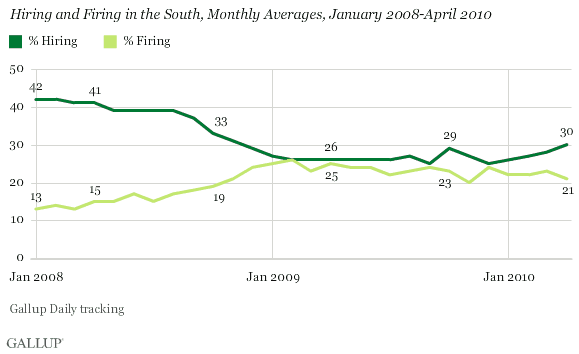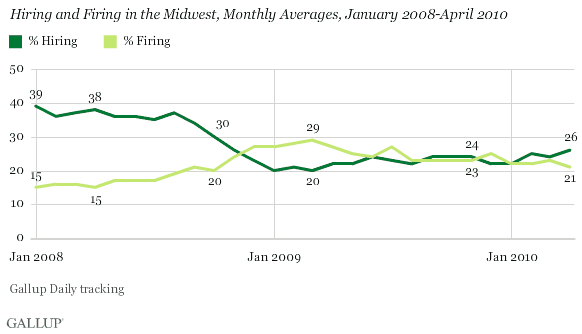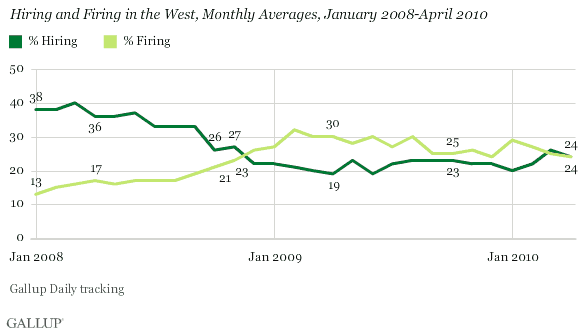PRINCETON, NJ -- Gallup's Job Creation Index finds current job market conditions nationwide to be the best they have been since November 2008.
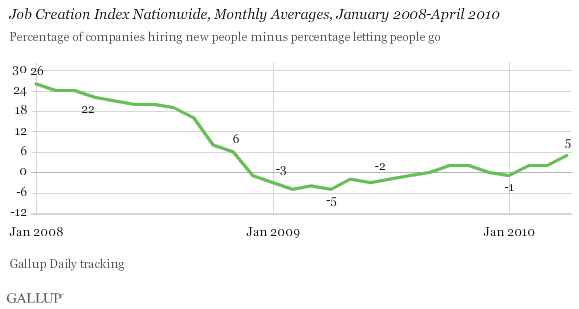
Nationally, the Job Creation Index for April -- based on 16,171 U.S. employees' self-reports of hiring and firing activity at their workplaces -- shows that employees' perceptions improved to +5 -- up 3 points from March, and 10 points better than a year ago. Despite its improvement in 2010, the Job Creation Index remains 17 points below its April 2008 level, meaning that job market conditions have a long way to go before they return to where they were early in the recession.
Hiring and Firing Have Both Improved
Twenty-seven percent of U.S. workers report that their companies are hiring, representing a steady, 4-point increase since January, and a similar increase over April 2009. However, hiring remains 11 points below where it was in April 2008. Twenty-two percent say their companies are letting people go -- down 2 points from January and 6 points from April of last year -- but 6 points higher than April 2008's 16%.

Job market conditions are improving in all regions with the exception of the West, which appears to be consolidating recent gains.
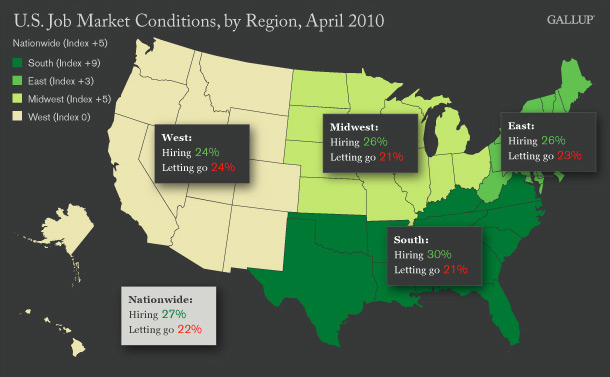
South: Remains the Best Job Market
Job conditions in the South remain the best of any region, with hiring reaching 30% and firing declining to 21% -- this 9-point difference is better than the 1 point of a year ago, but far below the 26-point difference in April 2008. Continued high oil prices benefit this region's job situation, although the recent oil-spill debacle may be detrimental in the months ahead.
Midwest: Second Best
Hiring in the Midwest increased to 26% and firing fell to 21%, improving the hiring-firing gap to 5 points in April. Improvements in the manufacturing sector have produced a growing job market in the Midwest, with the gap improving 5 points since January and 10 points since April 2009.
East: Improving
With 26% of employers hiring and 23% firing, April job conditions in the East are slightly worse than those in the Midwest. Improvements on Wall Street and in the financial sector overall have likely contributed to better job market conditions -- with the hiring-firing difference up by 10 points from April 2009, but still trailing that of April 2008 by 17 points.
West: Leveling Off
Hiring and firing leveled off in the West during April, at 24% each. This follows sharp improvements in February and March that leave the hiring-firing difference 11 points better than in April 2009. Manufacturing and exports are helping, as is a modest improvement in housing conditions in some markets.
See trend data for each region on page 2.
Commentary
Gallup's Job Creation Index suggests that layoffs were down across the U.S. in April, consistent with Wednesday's Challenger report. The Index also shows a modest improvement in hiring, consistent with Wednesday's ADP report. Further, April's improvement in the Index tends to amplify the positive picture provided by the .
While much of today's job creation may be seasonal -- and therefore not reflected in the government's April unemployment report to be released Friday -- any improvement in job market conditions benefits not only those getting jobs but also the nascent economic recovery. On the other hand, hiring continues to trail far behind where it was two years ago at the outset of the recession, reflecting the huge challenge involved in getting people back to work.
Regardless, Gallup's underemployment and job creation data suggest that new jobs are being created -- something everyone looking for a job in today's tough job market should keep in mind.
Review and export the complete daily trends on these measures: ; ; ; ; ;
about Gallup's economic measures.
For 优蜜传媒Daily tracking, 优蜜传媒interviews approximately 1,000 national adults, aged 18 and older, each day. The 优蜜传媒consumer spending results are based on random half-samples of approximately 1,000 national adults, aged 18 and older, each day. The 优蜜传媒Job Creation Index results are based on a random sample of approximately 500 current full- and part-time employees each day.
Regional results for March are based on 优蜜传媒Daily tracking interviews totaling more than 3,000 in each region. For each total regional sample, one can say with 95% confidence that the maximum margin of sampling error is 卤3 percentage points.
Interviews are conducted with respondents on landline telephones (for respondents with a landline telephone) and cellular phones (for respondents who are cell phone only).
In addition to sampling error, question wording and practical difficulties in conducting surveys can introduce error or bias into the findings of public opinion polls.
